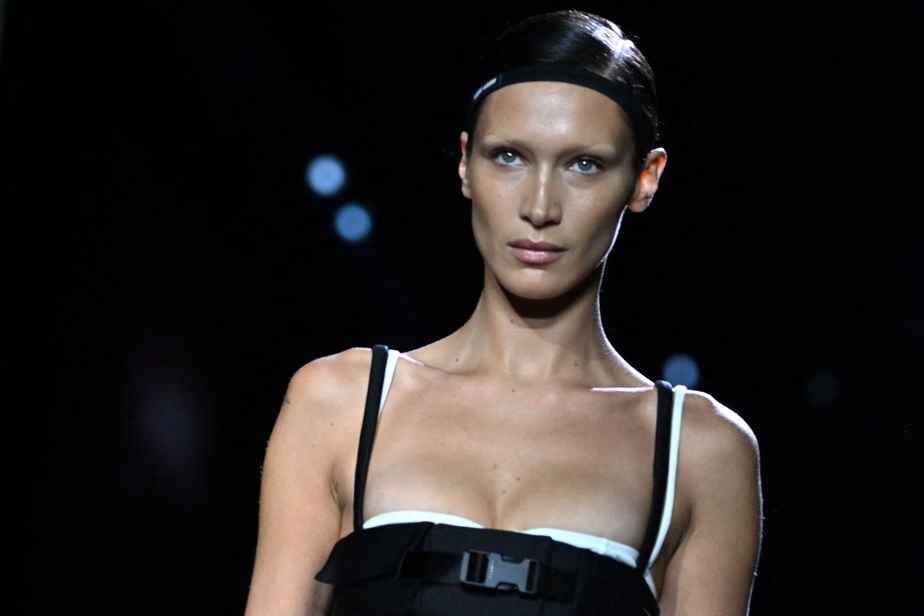The style chic heroin which marked the 1990s would be back in force on the fashion planet. Can this idealization of skinny bodies have an impact on girls and women? Yes, but only for some. Explanations.
At fashion shows in Europe this fall, we saw slim, very slim girls parading. Many popular beauty models right now — both on the runway and on social media — are all petite. Miniskirts and low-rise jeans are back in fashion. All these observations led the New York Post to establish an observation, this month: the chic heroin is back.
Those aged 40 and over will remember this early 1990s trend very well, as embodied by British model Kate Moss. Emaciated body, pale and angular face, dark circles around the eyes… In short, the look of someone who uses heroin, but who dresses well.

PHOTO FROM THE MIU MIU WEBSITE
Miu Miu’s spring summer collection recalls the aesthetics of the 1990s.
According to New York Post, therefore, the curves à la Kim Kardashian would give way to the skinny bodies of models like Bella Hadid, Kaia Gerber (daughter of Cindy Crawford) and Lila Moss (daughter of Kate Moss). Kim Kardashian herself is sporting an increasingly slim figure, noted the tabloid, which sees the trend as a “radical shift” from the body acceptance movement of recent years.
The article caused a stir, both in the press and in social networks, where women complained that the female silhouette could be considered a “trend”.
While the fashion industry once had a monopoly on images, social networks have promoted other ideals of beauty in recent years, such as the slim-thick – small size, flat stomach, rounded hips and thighs — and the look fit — thin, but with defined muscles.
Social networks, vehicles of the image
“Social media has really changed the landscape of beauty ideals by bringing more diversity, even if those other ideals aren’t necessarily easier to achieve,” notes Jennifer Mills, professor of psychology at the University of York in Toronto. , which focuses on body image and eating disorders. “But the ideal of thinness never really left: there is simply more variety of thin bodies”, she summarizes.

PHOTO HORST HERGET, SUPPLIED BY JENNIFER MILLS
Jennifer Mills
Nevertheless, among the models in sight at the moment, several are “very, very thin”, agrees Professor Mills, who spontaneously thinks of Kendall Jenner and Bella Hadid. Two girls who are extremely popular on social networks, who make a lot of money and who are seen a lot. “The more images you see, the more you internalize the fact that this is what is popular, and that this must be what is beautiful and attractive”, summarizes Jennifer Mills.

PHOTO EVAN AGOSTINI, ASSOCIATED PRESS ARCHIVES
Kendall Jenner, child of reality TV today model
On TikTok, viral trends are pretexts for some Internet users to communicate their weight loss tips, such as “What I eat in a day” or “My name is Bella Hadid”. With Bella Hadid’s voice in the background, tiktokers explain when they feel like her: after fasting, after going without dessert, after eating salad…
When you search for “thinspiration” in its search engine, TikTok now refers to an eating disorder help center.
Consequences… variable
Can these idealized images of very thin girls cause eating disorders in those who see them a lot?
According to pediatrician Jean Wilkins, who treats adolescent girls at the CHU Sainte-Justine, it is “very, very rare” for a patient to say she wants to look like a public figure. “What I see more in the last few years are teenage girls who don’t necessarily want to be such and such a person, but who just don’t want to be who they are,” he says.
The images probably have a limited effect on the development of anorexia nervosa, which results from a genetic predisposition, stresses Professor Jennifer Mills. They can, however, encourage girls and women to diet, she says. And for some women, these diets can cause bulimic behavior or even overtraining.
Of course, these standards of beauty also generate bodily dissatisfaction… but for some women only, nuance Jennifer Mills: those who tend to compare their bodies to those they see in the pictures, and those who believe that they would be happier if they looked like that.
“It’s also something you can work on with children: separate the fact of having a thin body from having a better life,” she advises.
Managing Director and co-founder of the Center for Online Emotional Intelligence, Emmanuelle Parent agrees that the ideal of thinness is very present in social networks. It is propagated by stars like Bella Hadid, but also through the advertising of the powerful fashion and slimming industries.
However, the abundance of these images varies from one profile to another, depending on the algorithms. Emmanuelle Parent’s Instagram and TikTok feeds are more rooted in body diversity, because she follows the accounts of people who are campaigning in this direction.
“The little control we have is precisely to subscribe to pages that encourage us to find ourselves beautiful, underlines Emmanuelle Parent. What we send as a message to the platform is that these are things that are worth sharing and spreading. »
soothing pictures
Danae Mercer’s Instagram account
-

PHOTO FROM DANAE MERCER’S INSTAGRAM ACCOUNT
“You didn’t get up this morning to hate your thighs. »
-

PHOTO FROM DANAE MERCER’S INSTAGRAM ACCOUNT
“Remember, it’s not a dream body if it’s a nightmare to maintain it. »
-

PHOTO FROM DANAE MERCER’S INSTAGRAM ACCOUNT
“Relax. Asked. Layered and retouched. »
-

PHOTO FROM DANAE MERCER’S INSTAGRAM ACCOUNT
-

PHOTO FROM DANAE MERCER’S INSTAGRAM ACCOUNT
“Talk to yourself as you would talk to someone you love. »
1/5
With her 2.3 million followers on Instagram, American journalist Danae Mercer is one of those who encourage women to feel good about their bodies and to stop comparing themselves to the unrealistic images circulating on social networks.
